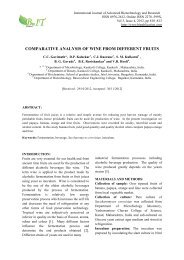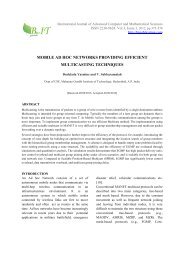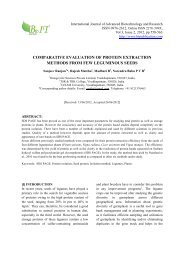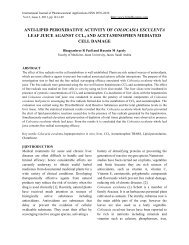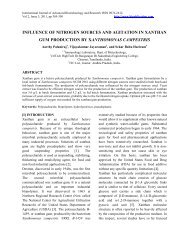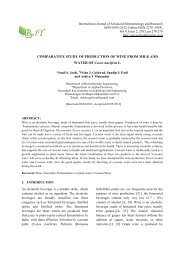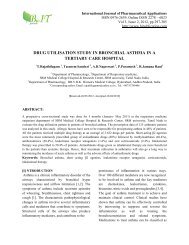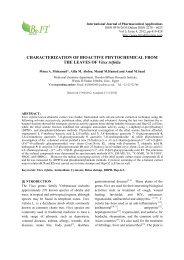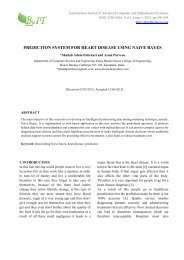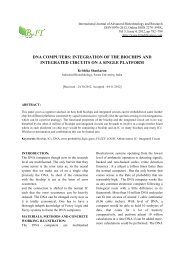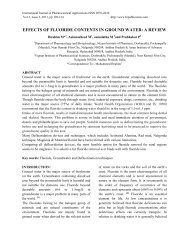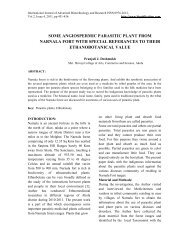isolation and characterization of chromium removing bacteria from ...
isolation and characterization of chromium removing bacteria from ...
isolation and characterization of chromium removing bacteria from ...
Create successful ePaper yourself
Turn your PDF publications into a flip-book with our unique Google optimized e-Paper software.
ISOLATION AND CHARACTERIZATION OF CHROMIUM REMOVING BACTERIAzinc, cobalt <strong>and</strong> <strong>chromium</strong>. Among heavymetals <strong>chromium</strong> is the major pollutant <strong>of</strong> theleather tanning industry <strong>and</strong> is toxic to plants<strong>and</strong> animals around the environment [9].The damage to the environment by thehazardous tannery effluent is becoming anacute problem in several countries. Thechrome tanning process results in toxicmetals, especially <strong>chromium</strong> III passing towaste water <strong>and</strong> are not easily eliminated byordinary treatment process [13]. Tannerywaste waters are mainly characterized byhigh salinity, high organic loading <strong>and</strong>specific pollutants such as <strong>chromium</strong> [10].The industrial effluent released directly orindirectly into natural water resources, mostlywithout proper treatment, poses a majorthreat to the environment.Among the different forms <strong>of</strong> <strong>chromium</strong>, thehexavalent <strong>chromium</strong> Cr 6+ is the most toxic<strong>and</strong> carcinogenic due to its high solubility inwater, rapid permeability through biologicalmembranes <strong>and</strong> subsequent interaction withintracellular proteins <strong>and</strong> nucleic acids. Theheavy metals in general cannot bebiologically transformed to more or less toxicproducts <strong>and</strong> hence persist in the environmentindefinitely [35]. They are significantly toxiceven in small amounts <strong>and</strong> can cause diseasesin humans <strong>and</strong> animals as they causeirreversible changes in the body, especially inthe Central Nervous System [26]. Soilcontamination by heavy metals is <strong>of</strong>tenirreversible <strong>and</strong> may repress or even kill parts<strong>of</strong> the microbial community <strong>and</strong> it isgenerally assumed that the exposure to metalsleads to the establishment <strong>of</strong> a tolerant/resistant microbial population [32].Microorganisms play a significant <strong>and</strong> vitalrole in bioremediation <strong>of</strong> heavy metalcontaminated soil <strong>and</strong> wastewater.Indigenous soil microbes appear well suitedfor Chromium (VI) transformation in highlycontaminated soil <strong>and</strong> may accumulate<strong>chromium</strong> within its cells by adaptation to thehigh concentration <strong>of</strong> the metal. Very stablefinal <strong>chromium</strong> forms can be achieved as aresult <strong>of</strong> microbial activity, with minimal risk<strong>of</strong> re-release <strong>of</strong> Cr (VI) [22]. In this paper aneffort has been made to remove heavy metals<strong>from</strong> tannery effluent using microorganisms.[II] MATERIALS AND METHODS2.1 Tannery EffluentThe effluent was collected <strong>from</strong> a selectedleather processing industry situated atDindigul in Tamil Nadu, India at weeklyintervals for five weeks, pooled together <strong>and</strong>stored at 4 °C for analysis. The collectedtannery effluent was analyzed forphysicochemical properties like colour,odour, turbidity, pH, total suspended solids,total dissolved salts, chemical oxygendem<strong>and</strong> (COD), biological oxygen dem<strong>and</strong>(BOD) [1], carbonate, bicarbonate, sodium,potassium [20], <strong>chromium</strong>, copper,cadmium, nickel <strong>and</strong> zinc [1].2.2 Isolation <strong>of</strong> the microorganism <strong>from</strong>tannery effluent contaminated soilFor <strong>isolation</strong> <strong>of</strong> <strong>chromium</strong> resistant <strong>bacteria</strong>,1.0 g effluent treated soil sample wasdispersed in 100 mL <strong>of</strong> the sterile distilledwater. A serial dilution was made up to 10 -5<strong>from</strong> the effluent treated soil sample. 100 µL<strong>of</strong> each dilution was spread on to nutrientplates containing 10 µg potassiumdichromate (K 2 Cr 2 O 7 ) per mL <strong>of</strong> themedium. The growth <strong>of</strong> the <strong>bacteria</strong>l colonieswas observed after 24 h <strong>of</strong> incubation at 37°C. It was subcultured on nutrient agar platecontaining 10 µg <strong>of</strong> potassium dichromate(K 2 Cr 2 O 7 ) per mL. Biochemical tests likeGram staining [27], dextrose fermentation,sucrose fermentation, IMViC, catalaseactivity, starch hydrolysis [11] <strong>and</strong> gelatinSmrithi A <strong>and</strong> Usha K 645



